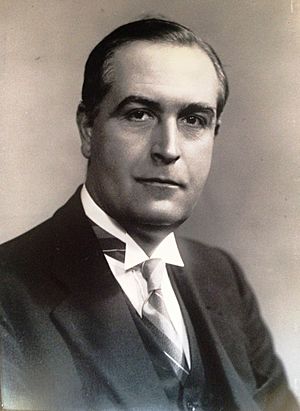Alfred Edwin Jones facts for kids
Quick facts for kids
Alfred Edwin Jones
|
|
|---|---|
 |
|
| Born | 14 August 1894 Shorncliffe, Kent, England
|
| Died | June 29, 1973 (aged 78) |
| Nationality | Irish |
| Occupation | Architect |
Alfred Edwin Jones (1894–1973) was a famous Irish architect. He collected many files about Irish architects. This collection became the main source for the Dictionary of Irish Architects 1720–1940.
Contents
Early Life and Training
Alfred Edwin Jones was born in Shorncliffe, England, on August 14, 1894. His father was a soldier. Alfred spent his early childhood in Rawalpindi, a city where his father was stationed. In 1895, his family moved to Dublin, Ireland.
Alfred went to school at Belvedere College. After school, he decided to become an architect. Around 1911, he started training with the architecture firm Ashlin & Coleman. He quickly became known for his skills. His detailed drawing of the ceiling in Belvedere's Apollo Room was even shown in the Irish Builder magazine.
Two years later, he won a gold medal for a design of an iron railing and gate. This design was also published in the same magazine. By 1914, Alfred was working as an assistant for Rudolf Maximilian Butler. His reputation for excellent drawings grew. In 1918, his drawings of the Marino Casino won him the Downes Bronze Medal. The judges said his work was "one of the finest specimens of draughtsmanship ever produced."
Professional Career
Starting His Own Practice
In 1919, Alfred Jones worked with Aubrey Vincent O’Rourke for a few months. Later that year, he started his own architecture firm with Stephen Stanislaus Kelly. They had known each other since they were kids.
In 1920, their firm, called 'Jones & Kelly', won a competition to design the Ballymena Town Hall. In 1923, they won another big competition for the Cork City Hall design. They continued to work together until Stephen Kelly passed away in 1951. After that, Alfred brought his son, Felix Alfred Jones, and his elder daughter, Elisabeth Fleming, into the business. He continued to advise the firm for the rest of his life.
Alfred's grandson, also named Alfred E. Jones, later took over the practice. He was also a talented designer. He won a special scholarship while he was a student. He designed many homes in Dublin. He was also an expert in saving and restoring old buildings. Some of his projects included 'The Burgage' in Dalkey and 'Rock Lodge' in Limerick.
Major Projects
Alfred Jones and Stephen Kelly designed many different types of buildings. They created churches, schools, cinemas, theaters, factories, and housing projects. Some of their most famous works include:
- Screen Cinema, Dublin (1920, 1930)
- Ballymena Town Hall, County Antrim (1928)
- Church of the Four Masters, Athlone (1930)
- Mount Mellerary Cistercian Abbey, County Waterford (1924–27, 1933)
- DeLuxe Cinema, Dublin (1933)
- The Green Cinema, Dublin (1935)
- Cork City Hall (1936) – its concert room is known for its amazing sound!
- Irish Pavilion for the Empire World Exhibition, Glasgow (1938)
- The National Stadium (1939)
- St. Francis Church, Cork City (1949)
The Jones & Kelly firm was known for training many young architects. Over a hundred people learned their skills there. Many of these apprentices later became important Irish architects. One of them was Michael Scott. He worked for Jones & Kelly between 1923 and 1926. Michael Scott later designed modern buildings like Dublin's Busáras (bus station). He felt that Jones & Kelly's focus on older styles like Gothic, Renaissance, or Romanesque was a bit old-fashioned.
Alfred's grandson, Alfred E Jones, updated the practice. He designed modern buildings like 'The Marr House' in Howth. He also worked on renovating and redeveloping protected old buildings.
Family
Alfred Edwin Jones lived at 7 Ailesbury Road in Dublin, Ireland. You can see old photos of his home here.
His great-grandson, Felix Jones, is a well-known international rugby coach and a former rugby player for Ireland.
Other Interests
Alfred Jones had many interests outside of architecture. He loved history, art, and sports. He was very interested in Archaeology and Egyptology. In his later years, he spent a lot of time creating a detailed list of Irish architects and engineers. He also looked through the Irish Builder magazine for interesting information.
His research is now kept at the Irish Architectural Archive. It is a very important part of their database of Irish architects from 1720 to 1940. A portrait of Alfred Jones hangs in the Archive's reading room. It honors his amazing research.
Alfred Jones also collected stamps. He had a highly valued collection of old French stamps. He was also a violinist and performed in the La Scala Theatre in Dublin when he was young. For sports, he was a lifelong member of the Old Belvedere R.F.C. rugby club. He was also involved with the Irish Amateur Boxing Association. He even designed their home, the National Stadium, with Stephen Kelly. Alfred was a leader in the boxing association and served as its president for over 20 years.
Death
Alfred Jones passed away on June 29, 1973. He was buried in Tallaght, County Dublin, on July 2. He was married to Mary (née Ardiff) for 50 years. She lived until 1986. They had three children: Elizabeth, Felix, and Marie, who was a talented musician. Elizabeth and Felix continued to run the Jones & Kelly architecture firm after their father's death.

